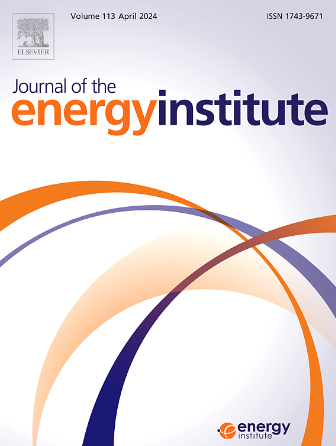Effect of process variables on hydrothermal carbonization of food waste
IF 5.6
2区 工程技术
Q2 ENERGY & FUELS
引用次数: 0
Abstract
The hydrothermal carbonization (HTC) of food waste (FW) was examined in this study under a variety of conditions, including temperatures of 200 °C, 225 °C, and 250 °C, reaction times of 1.5, 3, 6, and 12 h, and FW-to-water ratios of 12.5, 25, and 50 g/150 mL. HTC was selected as the treatment method due to its suitability for high-moisture feedstocks like FW, as it operates under relatively mild conditions without requiring energy-intensive drying. In this study, a simulated FW mixture was used, composed of commonly discarded household items including canned green beans, canned baked beans, baked potato, baked chicken, and cheese. The study explored how variations in process parameters influenced both the yield and structural properties of hydrochars, revealing their critical role in determining final product characteristics. The hydrochars exhibited higher carbon and lower oxygen weight percentages compared to the FW. Fuel ratio (FR) values ranged from 0.20 to 0.83, with most hydrochars demonstrating moderately stable solid biofuel characteristics. Based on the heating values, it was observed that the hydrochars' values ranged between ∼28 and ∼33 MJ/kg, aligning with the heating value of bituminous coal. The prominent compounds detected in the aqueous phases included nitrogen-containing cyclic compounds, phenols, ketones, and amides. Overall, the findings demonstrate the potential of HTC as a sustainable waste-to-energy strategy, effectively converting FW into hydrochars with favorable fuel properties and supporting energy recovery from organic waste streams.

工艺参数对餐厨垃圾水热碳化的影响
本研究在温度为200°C、225°C和250°C,反应时间为1.5、3、6和12 h,水热比为12.5、25和50 g/150 mL的条件下对食物垃圾(FW)的水热碳化(HTC)进行了研究。选择HTC作为处理方法是因为它在相对温和的条件下运行,不需要耗能干燥,适合于食物垃圾等高水分原料。在本研究中,使用了一种模拟的FW混合物,由常见的废弃生活用品组成,包括罐装四季豆、罐装烤豆、烤土豆、烤鸡和奶酪。该研究探讨了工艺参数的变化如何影响碳氢化合物的产率和结构特性,揭示了它们在决定最终产品特性方面的关键作用。与FW相比,烃类具有较高的碳质量百分比和较低的氧质量百分比。燃料比(FR)值在0.20到0.83之间,大多数碳氢化合物表现出中等稳定的固体生物燃料特性。根据热值,观察到碳氢化合物的热值在~ 28 ~ ~ 33 MJ/kg之间,与烟煤的热值一致。在水相中检测到的主要化合物包括含氮环化合物、酚类、酮类和酰胺类。总的来说,研究结果证明了HTC作为一种可持续的废物能源战略的潜力,有效地将FW转化为具有良好燃料性能的碳氢化合物,并支持从有机废物流中回收能源。
本文章由计算机程序翻译,如有差异,请以英文原文为准。
求助全文
约1分钟内获得全文
求助全文
来源期刊

Journal of The Energy Institute
工程技术-能源与燃料
CiteScore
10.60
自引率
5.30%
发文量
166
审稿时长
16 days
期刊介绍:
The Journal of the Energy Institute provides peer reviewed coverage of original high quality research on energy, engineering and technology.The coverage is broad and the main areas of interest include:
Combustion engineering and associated technologies; process heating; power generation; engines and propulsion; emissions and environmental pollution control; clean coal technologies; carbon abatement technologies
Emissions and environmental pollution control; safety and hazards;
Clean coal technologies; carbon abatement technologies, including carbon capture and storage, CCS;
Petroleum engineering and fuel quality, including storage and transport
Alternative energy sources; biomass utilisation and biomass conversion technologies; energy from waste, incineration and recycling
Energy conversion, energy recovery and energy efficiency; space heating, fuel cells, heat pumps and cooling systems
Energy storage
The journal''s coverage reflects changes in energy technology that result from the transition to more efficient energy production and end use together with reduced carbon emission.
 求助内容:
求助内容: 应助结果提醒方式:
应助结果提醒方式:


